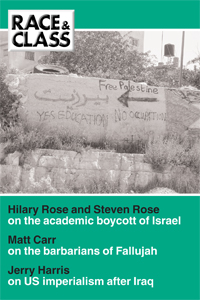Description
Race & Class – the next thirty years, by A. Sivanandan
It was thirty years ago that the first issue of the Institute of Race Relations’ journal Race & Class appeared. It was a period of rapid, mass, social and political change; of major liberation struggles and the installation of popular governments and Race & Class opened its pages to analyse, report and reflect on these new realities. Now, under the impact of globalisation and the ‘war on terror’ that has reinscribed American imperial dominance even more brutally on the world, how should Race & Class respond to these new challenges and dangers? And how should it reach out to the new movements and constituencies seeking to counter them? These are the questions addressed by A. Sivanandan in a talk given to mark the first thirty years of the journal. It is published here together with a prose poem written for the occasion by John Berger, entitled ‘A mouth speaks out alone’.
Emerging Third World powers: China, India and Brazil, by Jerry Harris
China, India and Brazil have become world economic powers; they are attempting to harness the forces of globalisation so as to strengthen their international standing in multilateral institutions like the WTO. Theirs is not a surrender to imperialism but an attempt to build a bulwark against it, from which they can implement their own national strategies for development – strategies that are qualitatively different from those followed by the non-aligned movement after Bandung. While each country is pursuing a somewhat different path, their collective might within the G-20 is already forcing concessions on trade, agriculture and subsidies from the US and EU. But do such growing South-South economic linkages have the potential to transform the global balance of power?
The new frontiers of America, by Ruben Andersson
Through a mixture of oral testimony, analysis and personal encounter, the harsh and deadly penalties meted out to those attempting to travel across the Mexican border into the United States are evoked. Many have already suffered extensively at the hands not only of corrupt police and marauding paramilitary gangs as they travel into Mexico, even before risking their lives to go further North. Devastated economies, in hock to ‘trade’ agreements dictated by the US render these journeys essential – for migrant remittances now outstrip oil and agriculture in many national economies. Yet failure – and many do fail – can entail robbery, rape, mutilation and murder.
Robert Louis Stevenson: class and ‘race’ in The Amateur Emigrant, by Lawrence Phillips
In 1879, an impoverished Stevenson travelled from Scotland to California in conditions almost identical to those of working-class and poverty-stricken emigrants. His account, The Amateur Emigrant, shocked the class sensitivities of his family and friends, and was not published in full in his lifetime. The experience had a profound effect on Stevenson’s personal sensibilities; his consciousness of his ambivalent position as a middle-class writer in the midst of his working-class contemporaries renders The Amateur Emigrant a remarkable revelation of the intermingled complexities of class, race and gender in late Victorian England.
‘Black skull’ consciousness: the new Swedish working class, by Diana Mulinari and Anders Neergaard
The Swedish public and political landscape has changed in the last ten years. How do migrant workers organise within Swedish unions? Research in Sweden has, till now, focused on migrants as passive, ‘traditional’ and lacking democratic traditions. But this study analyses migrant trade union activists in their struggle to overcome constructions of them as ‘others’ and institutionalised union practices of racial subordination.
Diversity management can be bad for you, by John Wrench
Is diversity management the new tool to combat discrimination in employment, and how is it seen by both employers and union activists? A trend that began in North America, it is now being increasingly incorporated in European businesses. How it relates to equal opportunities, positive action and the attempt to dismantle racial discrimination in the workplace is closely analysed here. Attractive to employers, it can be a means of evading hard choices about equality and justice at work.
Race & Class is published quarterly, in January, April, July and October, by Sage Publications for the Institute of Race Relations; individual subscriptions are £27/$47, for four issues, with an introductory rate of £20/$35 for new subscribers.


